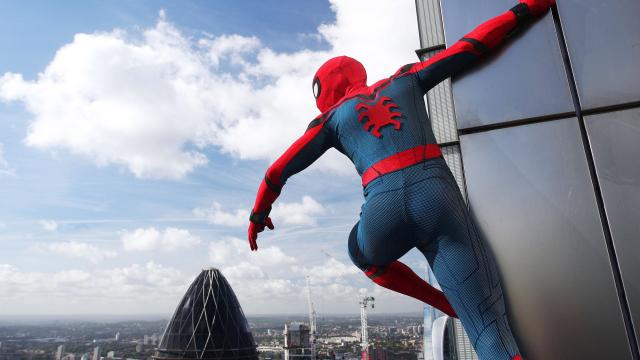One of the biggest differences between Spider-Man: Homecoming and its predecessors was Spidey’s suit. Not strictly the design, though — just the fact that it wasn’t as skin-tight as Tobey Maguire or Andrew Garfield’s form-fitting ensembles. And that was a headache for the computer graphics team behind it all.
In time for the launch of the latest Spider-Man movie on DVD and Blu-ray, we talked to Homecoming‘s visual effects supervisor Theo Bialek, who’s also worked on other visually lush films like Speed Racer and Beowulf, to see how the latest reimagining of Marvel’s suited student taxed the Imageworks team at Sony.
Spider-Man has had a huge variety of ‘looks’ over the years; how did the team work on making him look unique and distinctive for Homecoming?
For Spider-Man: Homecoming Imageworks was tasked with building a digital version of Spider-Man’s suit. The designs for this suit were firmly established and locked as the costume was shot practically for several scenes in the movie. His homemade suite, being mostly loose-fitted sweatpants, was very different than all of the skintight bodysuits Spider-Man has worn in previous films.
The biggest challenges we faced when recreating the suit digitally were capturing the subtleties of the fabric. Over 100 of our shots required an all CG version of Spider-Man, so a significant amount of time was spent on the R&D process — defining the physics of the fabric — before simulations began on actual shots.
Were there any elements that stood out for Homecoming for you in terms of VFX? Was there anything particularly hard to create or that had a strong visual impact?
[The] plane battle sequence was a difficult VFX element to create because so many of the shots were entirely CG. With 90 all-CG versus 20 plate-based shots, very few practical elements were available to anchor our shots in reality. Creating a versatile cloud environment for our plane to fly through along with CG city blocks was a substantial undertaking. The complexity of the plane and the characters’ battle stands out as a particular challenge.
The script called for a cloaked transport plane that effectively could render the vehicle invisible within the limits of current-day technology. Creating the arrays of LEDs required to achieve this effect was a huge effort on the part of our team. On its most basic level, we were covering our CG modified C-17 military cargo plane with high density electronic billboards. Then generating 360 degree footage, similar in fashion to today’s VR camera rigs, to play on those screens.
The end effect was a plane that attempted to cover its skin with a dynamic picture of its environment so as to camouflage itself from the viewer. Our FX artists were able to do this by instancing over one million LEDs on the surface of the plane, each capable of being a unique light source that could illuminate our hero as he battled along its shell. The amount of light sources and geometry required to create this effect pushed the limits of our renderer and our team.
How have you seen VFX tech evolve over your career? Has your job become simpler or more complicated? Is there a constant cycle of keeping up with new tools?
The sophistication of the software we use to create our shots has definitely evolved in orders of magnitude over the 20 or so years I’ve been in the industry. The tools we used in the late 90s were quite slow, complex and highly subjective. Software packages across all disciplines in VFX now rely so much more on objective simulations than ever before.
Our renderers are virtually all global illumination raytracers that simulate conservation of energy. It still requires an artist to place the light, but the qualities of the that light, the shadowplay, and how the materials respond are for all practical purposes automatically solved by the software. In a similar fashion the muscle, skin, hair and fabric of our characters are also physically simulated to a level far beyond what was possible even 10 years ago.
What we can achieve in a given amount of time has exponentially improved, but so too has the expectation of our filmmakers. The job has become more complicated in some ways — we have so many more elements to generate per shot, and yet simpler in others as we can rely more and more on the software to solve those for us. It is near impossible to keep up with all the software to the level of granularity required to operate them on an individual level, but as a supervisor it remains important to understand the tools on a basic level.
Spider-Man: Homecoming is available on digital from October 4 and Blu-ray and DVD from October 18.
